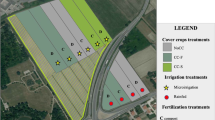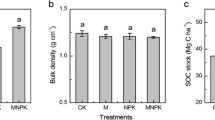Abstract
Purpose
While the influence of integrated fertility management systems on yield and N cycling in Mollisols is documented, its effect on soil C sequestration remains to be determined. We examined the response of organic C pools and crop yields to 21 years’ organic amendments applied at relatively low rates in a high-C Mollisol to optimize win–win management practices that balance agronomic and environmental interests.
Materials and methods
This study was based on five treatments: CK (unfertilized control), NPK (chemical fertilizer alone), NPKS1 (NPK plus crop residues), NPKS2 (NPK plus double amounts of crop residues), and NPKM (NPK plus pig manure). Crop yield was determined by harvesting a defined area. Organic C was quantified by dry combustion. A two-step acid hydrolysis technique was used to quantify hydrolysable and non-hydrolysable C fractions.
Results and discussion
All organic-treated plots produced significantly higher crop yields than the NPK plots, but only the manure treatment resulted in a significant increase in SOC compared with the NPK treatment after 21 years of experiment. It seems that the effects of organic amendments on SOC depend primarily on the type of organic materials when the application rates were relatively low. This indicated that organic amendments offer relatively short-term soil benefits for plant growth. The pig manure builds SOC over the long term, which provides secondary benefits while also sequestering C.
Conclusions
Overall, manure integrated with mineral fertilizer should be recommended to maintain the SOC content and increase crop yield in the Mollisols.
Similar content being viewed by others
References
Belay-Tedla A, Zhou X, Su B, Wan S, Luo Y (2009) Labile, recalcitrant, and microbial carbon and nitrogen pools of a tallgrass prairie soil in the US Great Plains subjected to experimental warming and clipping. Soil Biol Biochem 41:110–116
Buysse P, Roisin C, Aubinet M (2013) Fifty years of contrasted residue management of an agricultural crop: impacts on the soil carbon budget and on soil heterotrophic respiration. Agric Ecosyst Environ 167:52–59
Campbell CA, Bowren KE, Schnitzer M, Zentner RP, Townley-Smith L (1991) Effect of crop rotations and fertilization on soil organic matter and some biochemical properties of a thick Black Chernozem. Can J Soil Sci 71:377–387
Campbell CA, McConkey BG, Zentner RP, Selles F, Curtin D (1996) Long-term effects of tillage and crop rotations on soil organic C and total N in a clay soil in southwestern Saskatchewan. Can J Soil Sci 76:395–401
Ding X, Han X, Liang Y, Qiao Y, Li L, Li N (2012) Changes in soil organic carbon pools after 10 years of continuous manuring combined with chemical fertilizer in a Mollisol in China. Soil Till Res 122:36–41
Doyle GL, Rice CW, Peterson DE, Steichen J (2004) Biologically defined soil organic matter pools as affected by rotation and tillage. Environ Manage 33:S528–S538
Drinkwater LE, Wagoner MW, Sarrantonio M (1998) Legume-based systems have reduced losses of nitrogen and carbon. Nature 396:262–265
Greenfield LG, Gregorich EG, van Kessel C et al (2013) Acid hydrolysis to define a biologically-resistant pool is compromised by carbon loss and transformation. Soil Biol Biochem 64:122–126
Hassink J (1997) The capacity of soils to preserve organic C and N by their association with clay and silt particles. Plant Soil 191:77–87
Helfrich M, Flessa H, Mikutta R, Dreves A, Ludwig B (2007) Comparison of chemical fractionation methods for isolating stable soil organic carbon pools. Eur J Soil Sci 58:1316–1329
Kong YY, Six J, Bryant DC, Denison RF, van Kessel C (2005) The relationship between carbon input aggregation, and soil organic carbon stabilization in sustainable cropping systems. Soil Sci Soc Am J 69:1078–1085
Kukal SS, Rehana R, Benbi DK (2009) Soil organic carbon sequestration in relation to organic and inorganic fertilization in rice–wheat and maize–wheat systems. Soil Till Res 102:87–92
Lal R (2003) Carbon sequestration in dryland ecosystems. Environ Manag 33:528–544
Li HB, Han XZ, Qiao YF, Hou XY, Xing BS (2009) Carbon dioxide emission from black soil as influenced by land-use change and long-term fertilization. Commun Soil Sci Plant Anal 40:350–1368
Li LJ, You MY, Shi HA, Ding XL, Qiao YF, Han XZ (2013) Soil CO2 emissions from a cultivated Mollisol: effect of organic amendments, soil temperature, and moisture. Eur J Soil Biol 55:83–90
Li Z, Liu M, Wu X, Han F, Zhang T (2010) Effects of long-term chemical fertilization and organic amendments on dynamics of soil organic C and total N in paddy soil derived from barren land in subtropical China. Soil Till Res 106:268–274
Lützow MV, Kögel-knabner I, Ekschmitt K, Matzner E, Guggenberger G, Marschner B, Flessa H (2006) Stabilization of organic matter intemperate soils: mechanisms and their relevance under different soil conditions—a review. Eur J Soil Sci 57:426–445
Malhi SS (2012) Relative effectiveness of various amendments in improving yield and nutrient uptake under organic crop production. Open J Soil Sci 2:299–311
Marschner B, Brodowski S, Dreves A et al (2008) How relevant is recalcitrance for the stabilization of organic matter in soils? J Plant Nutr Soil Sci 171:91–110
McColl JG, Gressel N (1995) Forest soil organic matter: characterization and modern methods of analysis. In: McFee WW, Kelly JM (eds) Carbon forms and functions in forest soils. SSSA, Madison, pp 13–32
Melero S, Porras JCR, Herencia JF, Madejon E (2006) Chemical and biochemical properties in a silty loam soil under conventional and organic management. Soil Till Res 90:162–170
Paul EA, Collins HP, Leavitt SW (2001) Dynamics of resistant soil carbon of Midwestern agricultural soils measured by naturally occurring 14C abundance. Geoderma 104:239–256
Powlson DS, Olk DC (2000) Long-term soil organic matter dynamics. In: Kirk GJD, Olk DC (eds) Carbon and nitrogen dynamics in flooded soils. International Rice Research Institute, Makati City, pp 49–63
Rathod DD, Rathod PH, Patel KP, Patel KC (2013) Integrated use of organic and inorganic inputs in wheat–fodder maize cropping sequence to improve crop yields and soil properties. Arch Agron Soil Sci 59:1439–1455
Rovira P, Vallejo VR (2002) Labile and recalcitrant pools of carbon and nitrogen in organic matter decomposing at different depths in soil: an acid hydrolysis approach. Geoderma 107:109–114
Rudrappa L, Purakayastha TJ, Singh D, Bhadraray S (2006) Long-term manuring and fertilization effects on soil organic carbon pools in a Typic Haplustept of semi-arid sub-tropical India. Soil Till Res 88:180–192
Russell AE, Cambardella CA, Laird DA, Jaynes DB, Meek DW (2009) Nitrogen fertilizer effects on soil carbon balances in Midwestern U.S. agricultural systems. Ecol Appl 19:1102–1113
Schmidt MWI, Torn MS, Abiven S et al (2011) Persistence of soil organic matter as an ecosystem property. Nature 478:49–56
Silveira ML, Comerford NB, Reddy KR, Cooper WT, El-Rifai H (2008) Characterization of soil organic carbon pools by acid hydrolysis. Geoderma 144:405–414
Six J, Conant RT, Paul EA, Paustian K (2002) Stabilization mechanisms of soil organic matter: implications for C-saturation of soils. Plant Soil 241:155–176
Smith P, Powlson DS, Glendining MJ, Smith JU (1997) Potential for carbon sequestration in European soils: preliminary estimates for five scenarios using results from long-term experiments. Glob Change Biol 3:67–79
Soil Survey Staff (2010) Keys to soil taxonomy, 11th edn. USDA-Natural Resources Conservation Service, Washington DC
Stewart CE, Paustian K, Conant RT, Plante AF, Six J (2009) Soil carbon saturation: implications for measurable carbon pool dynamics in long-term incubations. Soil Biol Biochem 41:357–366
Sun Y, Huang S, Yu X, Zhang W (2013) Stability and saturation of soil organic carbon in rice fields: evidence from a long-term fertilization experiment in subtropical China. J Soils Sediments 13:1327–1334
Tobiasova E (2011) The effect of organic matter on the structure of soils of different land uses. Soil Till Res 114:183–192
Yadav R, Dwivedi BS, Prasad K, Tomar OK, Shurpali NJ, Pandey PS (2000) Yield trends, and changes in soil organic C and available NPK in a long-term rice–wheat system under integrated use of manures and fertilizers. Field Crops Res 68:219–246
Acknowledgments
This work was financially supported by the fund of Excellent Young Talent, Northeast Institute of Geography and Agroecology, Chinese Academy of Sciences (DLSYQ12002), Science Foundation of the Chinese Academy of Sciences (KZZD-EW-TZ-16-02), and the National Natural Science Foundation of China (41371295). We deeply appreciate the Editor-in-Chief and the two anonymous reviewers for their insightful and constructive comments on this paper.
Author information
Authors and Affiliations
Corresponding authors
Additional information
Responsible editor: Leo Condron
Rights and permissions
About this article
Cite this article
Ding, X., Yuan, Y., Liang, Y. et al. Impact of long-term application of manure, crop residue, and mineral fertilizer on organic carbon pools and crop yields in a Mollisol. J Soils Sediments 14, 854–859 (2014). https://doi.org/10.1007/s11368-013-0840-x
Received:
Accepted:
Published:
Issue Date:
DOI: https://doi.org/10.1007/s11368-013-0840-x




